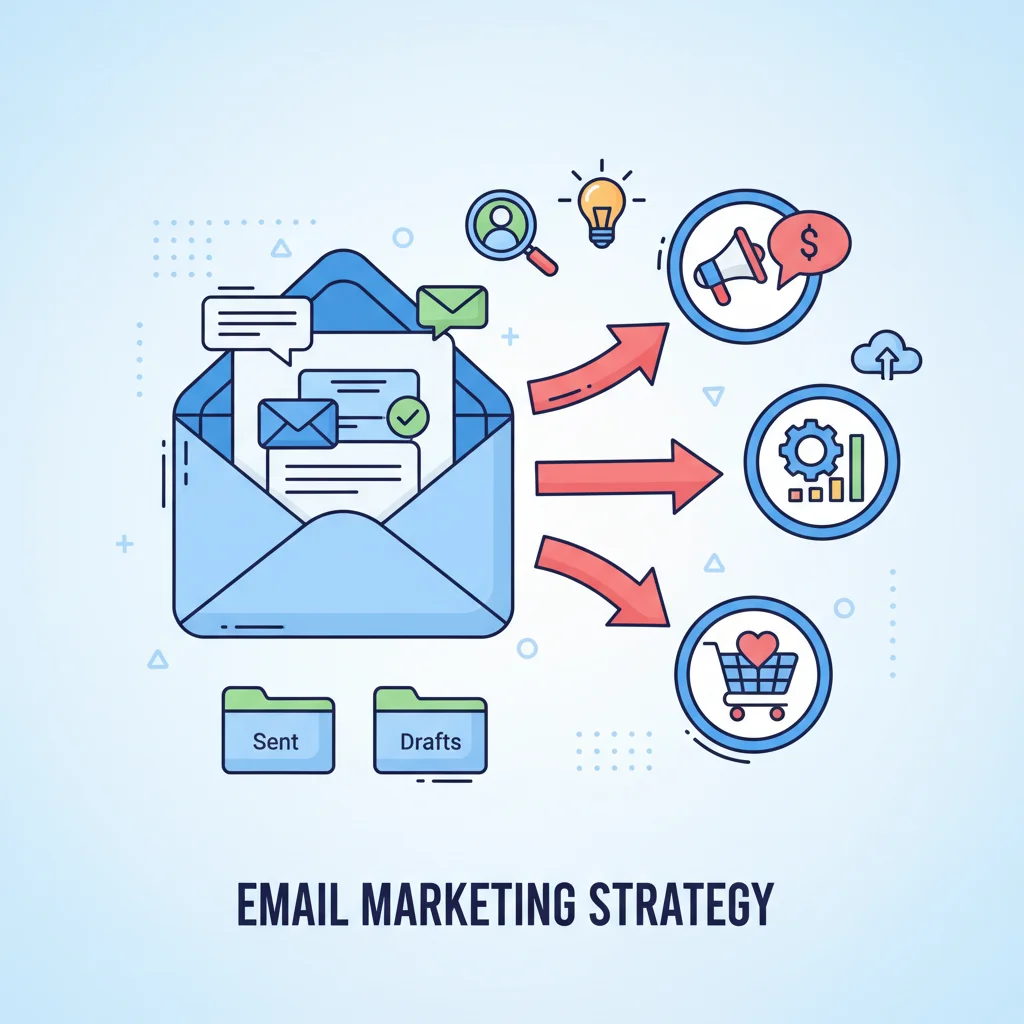Now Reading: Transactional vs Marketing Email Differences: What You Need to Know
-
01
Transactional vs Marketing Email Differences: What You Need to Know
Transactional vs Marketing Email Differences: What You Need to Know

Your emails aren’t getting the engagement they deserve. Maybe you’re treating all your emails the same way, missing the critical transactional vs marketing email differences that could dramatically improve your results. When you blur these lines, you risk poor deliverability, missed opportunities, and confused customers. But there’s a solution – understanding exactly how these email types differ and when to use each one.
Key Takeaways
- Transactional emails are triggered by user actions (like purchases or password resets), contain specific information relevant to that action, and typically achieve 80-85% open rates.
- Marketing emails aim to promote products/services, are sent to groups of contacts, and generally see 20-25% open rates.
- The primary differences include purpose (information vs. promotion), content (specific vs. general), regulatory requirements (exempt vs. regulated), and delivery importance (immediate vs. scheduled).
- Transactional emails are exempt from certain regulations like CAN-SPAM and GDPR, while marketing emails must comply with these laws.
- Understanding these differences helps optimize both email types for better engagement, deliverability, and conversion rates.
What Are Transactional Emails?
Transactional emails are the workhorses of your email strategy. These automated messages get triggered when a user takes a specific action on your website or app. Think order confirmations, password resets, shipping notifications-all those emails that provide essential information about something the user has already done.
Unlike their flashier marketing cousins, transactional emails are straightforward and to the point. They deliver critical information that users actually want and expect to receive. That’s why they boast those impressive 80-85% open rates I mentioned earlier.
Common Types of Transactional Emails
- Order confirmations and receipts – Confirming purchases and providing payment details
- Shipping notifications – Updates about order status and delivery
- Account-related messages – Password resets, account creation confirmations, security alerts
- Verification emails – Double opt-ins, email verification requests
- Feedback requests – Post-purchase surveys directly related to a specific transaction
Key Characteristics of Transactional Emails
Transactional emails have some distinct features that set them apart:
- Triggered by user actions – They’re sent in response to something the user did
- One-to-one communication – Each email contains unique information specific to the recipient
- Time-sensitive – Users expect to receive them quickly after the triggering action
- Highly relevant – They contain information the user needs or has requested
- Functional design – Clean, simple layouts that prioritize information over promotion
One thing I’ve noticed is that the best transactional emails focus on clarity above all else. Your customer just wants to know their order went through or their password was reset-don’t make them hunt for that information.
Useful Articles:
What Are Marketing Emails?
Marketing emails are your promotional tools. These are the newsletters, special offers, product announcements, and other messages you send to encourage recipients to take action-usually making a purchase or engaging more deeply with your brand.
Unlike transactional emails that respond to user actions, marketing emails initiate contact based on your schedule and strategy. They’re proactive rather than reactive.
Common Types of Marketing Emails
- Newsletters – Regular updates about your company, products, or industry
- Promotional campaigns – Special offers, discounts, and sales announcements
- Product announcements – New releases, updates, or features
- Educational content – How-to guides, tips, and other valuable information
- Abandoned cart reminders – Prompts to complete a purchase (these blur the line a bit)
Key Characteristics of Marketing Emails
Marketing emails have their own distinct traits:
- Sent on your schedule – You determine when they go out
- One-to-many communication – The same content goes to multiple recipients
- Promotional in nature – They aim to drive sales or engagement
- Creative design – More visually appealing with images, colors, and branding
- Persuasive content – Uses copywriting techniques to encourage action
I’ve found that the most effective marketing emails provide genuine value-not just a sales pitch. When you educate, entertain, or solve problems for your audience, they’re much more likely to engage with your promotional content.
Transactional vs Marketing Email Differences: A Detailed Comparison
Now let’s dig into the nitty-gritty differences between these two email types. Understanding these distinctions will help you optimize both types for maximum effectiveness.
Purpose and Intent
Transactional Emails:
- Provide essential information about an action the user has taken
- Fulfill an expected communication
- Focus on service and information delivery
- Build trust through reliability and usefulness
Marketing Emails:
- Promote products, services, or brand
- Initiate contact to drive desired actions
- Focus on persuasion and engagement
- Build interest through value and relevance
The fundamental difference is that transactional emails respond to user needs, while marketing emails aim to create needs or desires.
Content and Design
Transactional Emails:
- Simple, clean design that prioritizes information
- Minimal imagery and straightforward formatting
- Clear, concise copy focused on the specific transaction
- Limited promotional content (though some is allowed)
Marketing Emails:
- Eye-catching design with brand elements
- Rich imagery, colors, and varied formatting
- Persuasive copy focused on benefits and offers
- Entirely promotional in nature
I’ve seen too many businesses try to stuff their transactional emails with marketing messages. While you can include some promotional content, remember that the primary purpose is to deliver transaction information. Don’t make users hunt for their order details amid a sea of product recommendations!
Delivery and Timing
Transactional Emails:
- Triggered automatically by user actions
- Expected to arrive immediately after the triggering event
- Delivery speed is critical (delays cause concern)
- Sent individually based on user behavior
Marketing Emails:
- Scheduled according to marketing calendar
- Timing based on optimal engagement periods
- Delivery can be batched or staggered
- Sent to segments or lists of recipients
The timing expectations for these email types are completely different. If a password reset email takes 15 minutes to arrive, that’s a problem. If a newsletter arrives at 2pm instead of 10am, nobody really notices.
Regulatory Compliance
Transactional Emails:
- Exempt from many requirements of CAN-SPAM, GDPR, etc.
- Don’t require explicit opt-in (based on legitimate interest)
- Don’t legally require unsubscribe options (though best practice is to include them)
- Must still comply with data protection regulations
Marketing Emails:
- Must comply fully with CAN-SPAM, GDPR, and other regulations
- Require explicit opt-in consent
- Must include visible unsubscribe options
- Subject to stricter content and sending requirements
The regulatory differences are huge and getting them wrong can be costly. In the EU, sending marketing emails without proper consent can result in massive GDPR fines. Don’t mess around here-make sure you understand the legal requirements for each email type.
Performance Metrics
Transactional Emails:
- Typically see 80-85% open rates
- Very high click-through rates on functional links
- Success measured by delivery speed and clarity
- Performance relatively consistent over time
Marketing Emails:
- Average 20-25% open rates
- Variable click-through rates depending on offer
- Success measured by conversion and engagement
- Performance fluctuates based on content and timing
The performance gap between these email types is enormous. That’s not because transactional emails are “better”-it’s because they serve a different purpose and meet immediate user needs.
Useful Articles:
How to Optimize Transactional Emails
Now that we understand the differences, let’s look at how to make each email type more effective, starting with transactional emails.
Focus on Clarity and Speed
The primary goal of any transactional email is to deliver clear information quickly. Make sure:
- The subject line clearly states what the email is about
- The most important information appears at the top
- Design is clean and easy to scan
- Load time is minimal (avoid large images)
I’ve received order confirmations where I had to scroll through paragraphs of marketing copy just to find my order number. Don’t do that to your customers!
Personalize Appropriately
Transactional emails should be highly personalized, but in a functional way:
- Include the customer’s name
- Reference specific details of their transaction
- Provide relevant account information
- Include only product recommendations directly related to their purchase
Maintain Brand Consistency
While transactional emails are functional, they should still reflect your brand:
- Use your brand colors and logo (subtly)
- Maintain your brand voice (though more straightforward)
- Include contact information and support options
- Ensure the email comes from a recognizable sender name
Add Limited Promotional Elements
You can include some marketing in transactional emails, but follow these guidelines:
- Keep the ratio at roughly 80% transactional, 20% promotional
- Place promotional content after the transactional information
- Make sure promotions are relevant to the transaction
- Use subtle design to separate transactional and promotional content
Optimize for Mobile
More than half of all emails are opened on mobile devices, so:
- Use responsive design that works on all screen sizes
- Keep the layout simple and single-column
- Use adequate font sizes (minimum 14px)
- Ensure buttons are large enough to tap easily
How to Optimize Marketing Emails
Marketing emails need a different approach to maximize their effectiveness.
Craft Compelling Subject Lines
Your subject line determines whether your email gets opened:
- Keep it under 50 characters
- Create a sense of urgency or curiosity
- Avoid spam trigger words
- A/B test different approaches
I’ve found that subject lines that ask questions or hint at solving a problem tend to perform best.
Segment Your Audience
Not all marketing emails should go to everyone:
- Divide your list based on behavior, preferences, or demographics
- Create targeted content for each segment
- Send more relevant offers to each group
- Track which segments respond to which types of content
Focus on Benefits, Not Features
People don’t care about what your product does-they care about how it helps them:
- Highlight how you solve customer problems
- Show the end result, not just the process
- Use customer-centered language (“you” not “we”)
- Tell stories that illustrate benefits
Create Strong Calls to Action
Every marketing email should have a clear next step:
- Use action-oriented language
- Limit to one primary CTA per email
- Make buttons stand out visually
- Create a sense of urgency when appropriate
Test and Optimize Continuously
Marketing emails benefit enormously from ongoing testing:
- A/B test different elements (subject lines, CTAs, images)
- Track which content drives the most engagement
- Experiment with send times and frequencies
- Use the data to refine your approach
Useful Articles:
When to Use Hybrid Approaches
Sometimes the line between transactional and marketing emails blurs. Here’s when and how to combine elements of both:
Cart Abandonment Emails
These are triggered by user behavior (transactional) but aim to drive a purchase (marketing):
- Focus primarily on reminding users of items left behind
- Include product images and details
- Add a clear CTA to return to cart
- Consider adding a time-limited incentive
Post-Purchase Follow-ups
These build on a transaction but aim to drive additional engagement:
- Start with transaction-related content (delivery updates, etc.)
- Add relevant product recommendations
- Request reviews or feedback
- Offer loyalty program information
Account Activity Summaries
These provide information about account usage while encouraging more engagement:
- Include actual account activity data
- Highlight unused features or opportunities
- Suggest next steps or actions
- Maintain an informational tone with subtle promotional elements
Understanding transactional vs marketing email differences doesn’t mean you can never combine elements of both-it just means you need to be strategic about when and how you do it.
Understanding the fundamental transactional vs marketing email differences is crucial for any effective email strategy. By recognizing their distinct purposes, content approaches, regulatory requirements, and performance metrics, you can optimize each type for maximum impact. Transactional emails should prioritize clarity and immediacy, while marketing emails should focus on engagement and persuasion. When you respect these differences-and occasionally blend approaches where appropriate-you’ll create email experiences that truly resonate with your audience and drive better results for your business.





















